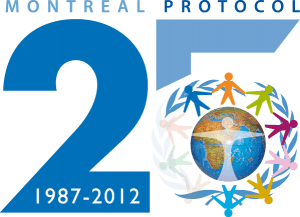Less incentive to produce R-22 and destroy HFC-23
 Established in 2005 , The United Nations created the Clean Development Mechanism which is a carbon trading system intending to decrease the amount of greenhouse gases emitted into the atmosphere. Countries participating in this program include the European Union, China, India, Mexico, Russia, Argentina and South Korea. In this market, one carbon credit is the equivalent of eliminating 1 ton of carbon dioxide. Gases
Established in 2005 , The United Nations created the Clean Development Mechanism which is a carbon trading system intending to decrease the amount of greenhouse gases emitted into the atmosphere. Countries participating in this program include the European Union, China, India, Mexico, Russia, Argentina and South Korea. In this market, one carbon credit is the equivalent of eliminating 1 ton of carbon dioxide. Gases
were rated on their power to warm the atmosphere. The more dangerous the gas, the higher their value.
HFC-23 is a byproduct of producing HCFC-22 refrigerant. HFC-23 has a value of 11,000 credits for every ton that is destroyed. To give you an idea of where this value falls in relation to other greenhouse emissions, carbon dioxide emissions from vehicles have a value of 1 credit and methane has a value of 21 credits for every ton that is destroyed. It is widely believed that the high value placed on HFC-23 is motivating R22 producers to increase production of R22 refrigerant. The United Nations reports that “the production of coolants was so driven by the lure of carbon credits for waste gas that in the first few years more than half of the plants operated only until they had produced the maximum amount of gas eligible for the carbon credit subsidy, then shut down until the next year.”
Michael Wara, a law professor at Stanford University, has calculated that in years when carbon credits were trading at high prices and coolant was dirt-cheap because of the oversupply, companies were earning nearly twice as much from the credits as from producing the coolant itself.
The United Nations is reducing the number of credits the coolant companies can collect in future contracts. Since 2007, credits have not been awarded to new factories destroying HF-23. Factories can now claim only 1% of their coolant production for carbon credit contract renewals.
With less reason to destroy HF-23, will manufacturers in developing countries continue to destroy it, or will they instead choose to vent it into the atmosphere? Will R22 production decrease in some nations?
 We at DynaCycle receive regular questions about what to do if a contractor customer thinks their recovery tank contains mixed gas. Here is our suggestion- Have your contractor customer drop off and tag the recovery cylinder.
We at DynaCycle receive regular questions about what to do if a contractor customer thinks their recovery tank contains mixed gas. Here is our suggestion- Have your contractor customer drop off and tag the recovery cylinder.


 “An overview of the latest in refrigerant recovery technology includes a step-by-step guide to applying the three most commonly used recovery methods”
“An overview of the latest in refrigerant recovery technology includes a step-by-step guide to applying the three most commonly used recovery methods”